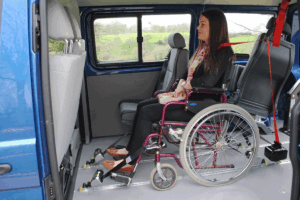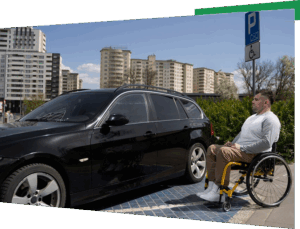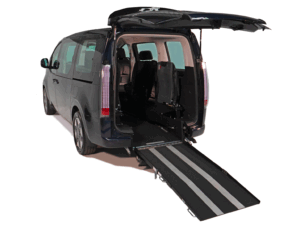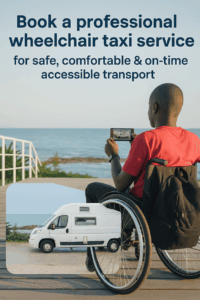Transporting wheelchair passengers safely and effectively requires specialized knowledge, proper equipment, and a commitment to providing dignified, accessible services. For individuals with mobility impairments in Melbourne and across Australia, wheelchair accessible vehicles (WAVs) represent more than just transportation—they provide essential access to independence, employment opportunities, healthcare, and social participation.
This comprehensive guide explores everything you need to know about wheelchair passenger transport, from regulatory requirements and safety procedures to choosing the right service provider. Whether you’re a transport operator, healthcare professional, or someone requiring accessible transport services, understanding these critical aspects ensures safe, compliant, and respectful transportation for all passengers.
Safe Wheelchair Transport Process – Complete Step-by-Step Guide for WAV Drivers
Legal Requirements and Australian Standards for Wheelchair Transport
Compliance with Australian Design Rules
All wheelchair accessible vehicles in Australia must comply with strict Australian Design Rules (ADRs) to ensure passenger safety and vehicle roadworthiness. Key compliance requirements include:
Vehicle Certification Standards:
- ADR 6/00 for reversing lamps and visibility systems
- ADR 42/04 covering general safety requirements including mirrors and visibility
- ADR 5/05 mandating proper seatbelt anchorage points
- ADR 34/02 for child restraint anchor points where applicable
Modification Approval Process:
Any vehicle converted to wheelchair accessible use must undergo re-certification to ensure continued compliance with safety standards. This process typically involves:
 • Engineering assessment by approved certifiers
• Engineering assessment by approved certifiers
• State-specific vehicle inspection procedures
• Issuance of modification plates or certificates
• Regular compliance monitoring and maintenance
A powered wheelchair user boarding a wheelchair-accessible van using a hydraulic ramp lift for safe transport.
Wheelchair Restraint and Safety Systems
Four-Point Tie-Down Requirements:
The foundation of safe wheelchair transport lies in proper restraint systems. Australian Standard AS/NZS 10542.1:2015 mandates that all wheelchair positions must feature:
• Four-point tie-down systems securing wheelchairs from two front and two rear attachment points
• Independent occupant restraints separate from wheelchair-mounted safety systems
• Regular inspection protocols to identify wear, fraying, or damage to restraint components
• Weight-appropriate restraints with heavy-duty systems required for wheelchairs exceeding 120kg
Occupant Safety Requirements:
Beyond wheelchair securement, passenger safety depends on proper occupant restraint systems:
- Lap-sash safety belts attached to the vehicle (not the wheelchair)
- Proper belt positioning avoiding throat and pelvis contact
- Headrest positioning directly behind the passenger’s head where provided
- Emergency release mechanisms accessible to both driver and passenger
Vehicle Specifications and Equipment Standards
Space and Accessibility Requirements
Minimum Space Allocations:
Each wheelchair position in a WAV must provide adequate space for safe transport:
- Floor space: Minimum 1300mm length × 800mm width per wheelchair position
- Height clearance: 1500mm minimum ceiling height as required by Disability Standards for Accessible Public Transport (DSAPT)
- Entry access: Door openings sufficient for wheelchair maneuvering
- Positioning requirements: Wheelchairs must face forward during transport for optimal safety
White wheelchair accessible vehicle with rear ramp deployed for easy wheelchair loading and transport.
Ramp and Lift Specifications
Ramp Safety Standards:
Wheelchair ramps must meet specific gradient and safety requirements:
- Maximum gradient: 1:6 (16.7%) when loaded with wheelchair and passenger
- Minimum width: 800mm to accommodate standard wheelchairs
- Surface requirements: Non-slip surfaces with safety edges mandatory
- Load capacity: Sufficient to handle wheelchair and occupant weight safely
Lift System Requirements:
For vehicles equipped with hydraulic lifts:
- Minimum capacity: 300kg lifting capability
- Safety systems: Emergency stop and manual override functions required
- Compliance standards: Must meet AS/NZS 3856.1:2021 for vehicle-mounted hoists
- Regular maintenance: Manufacturer or authorized agent servicing mandatory
Close-up of a metal wheelchair restraint system component used for securing wheelchairs in accessible vehicles safely.
Safe Loading and Unloading Procedures
Pre-Transport Safety Checks
Driver Responsibilities:
Before every wheelchair transport trip, drivers must complete comprehensive safety checks:
- Vehicle positioning: Legal parking in safe location with adequate loading space
- Equipment inspection: Verify all restraints, hoists, or ramps are in good working condition
- Passenger consultation: Ask permission before touching wheelchair or providing assistance
- Route planning: Identify accessible pickup and drop-off locations
Wheelchair Assessment:
Not all mobility aids are suitable for vehicle transport while occupied. Drivers must verify:
- Approved wheelchair types: Standard manual and electric wheelchairs with proper tie-down points
- Prohibited seating: Princess chairs, Duchess chairs, and high-care mobility aids cannot be transported with passengers seated
- Mobility scooter requirements: Passengers must transfer to vehicle seating with scooters secured separately
Loading Process Using Hoists
Step-by-Step Hoist Operation:
The Safe Transport Victoria guidelines specify a detailed process for hoist loading:
- Initial Setup:
- Position wheelchair safely away from hoist area
- Apply wheelchair brakes securely
- Open rear vehicle door and lower hoist to ground level
- Wheelchair Positioning:
- Release wheelchair brakes only when ready to move
- Position wheelchair on hoist platform facing forward
- Reapply brakes and verify stable positioning
- Lifting Procedure:
- Ensure passenger safety with legs and feet clear of danger zones
- Operate hoist with one hand controlling wheelchair, other on hoist controller
- Raise to vehicle floor level ensuring platform alignment
- Interior Positioning:
- Move wheelchair to designated position within vehicle
- Attach front anchorage restraints to wheelchair frame
- Install rear anchorage restraints and tighten using ratchet mechanisms
- Apply vehicle-mounted passenger seatbelt correctly positioned
Hyundai Staria wheelchair accessible vehicle with rear ramp extended for wheelchair passenger access.
Ramp Loading Procedures
Ramp-Based Wheelchair Loading:
For vehicles equipped with wheelchair ramps:
- Ramp deployment: Unlock and position ramp at safe angle for wheelchair access
- Front restraint preparation: Pre-position and unlock front restraints before loading
- Smooth boarding: Guide wheelchair up ramp using both hands for stability
- Securement process: Lock all restraints and apply passenger seatbelt
- Ramp stowage: Properly secure ramp before commencing travel
Driver Training and Certification Requirements
Mandatory WAV Endorsement
Licensing Requirements:
All commercial drivers transporting wheelchair passengers must obtain proper certification:
- W-Endorsement: Required for all WAV drivers providing commercial passenger services
- Competency assessment: Both theoretical and practical testing components
- Skills demonstration: Loading, securing, and unloading wheelchair passengers safely
- Communication training: Effective interaction with passengers having diverse needs
Ongoing Training Requirements:
Professional development doesn’t end with initial certification:
- Refresher training: Required every 12-18 months
- Equipment updates: Training on new vehicle technologies and safety systems
- Incident response: Procedures for medical emergencies and equipment failures
- Customer service: Disability awareness and respectful assistance techniques
A man in a wheelchair next to a car parked in a designated disabled parking space in an urban setting.
Best Practices for Driver Conduct
Professional Service Standards:
Quality wheelchair transport requires drivers who understand disability etiquette:
- Direct communication: Speak directly to passengers, not companions or interpreters
- Assistance protocols: Offer help but don’t insist if declined
- Dignity preservation: Treat passengers with disabilities as you would any other passenger
- Equipment respect: Never touch wheelchair joysticks or controls without permission
Safety-First Approach:
Driver vigilance protects all passengers:
- Equipment verification: Daily pre-operational checks of all safety systems
- Passenger priority: WAV drivers must prioritize wheelchair passenger bookings
- Assistance animals: Never refuse legitimate assistance animals or animals in training
- Emergency preparedness: Know procedures for medical incidents and equipment failures
Passenger Rights and Service Expectations
Transportation Accessibility Standards

Service Availability:
The Disability Standards for Accessible Public Transport establish minimum service levels:
- Equal access: Same booking procedures and response times as standard taxi services
- Equipment standards: All vehicles must meet accessibility specifications
- Driver competency: Properly trained personnel for all wheelchair transport services
- Reasonable assistance: Drivers must provide appropriate help with boarding and alighting
Multi-Purpose Taxi Program (MPTP):
Eligible passengers benefit from subsidized transport costs:
- Identification requirements: MPTP card with ‘Wheelchair/Scooter’ notation
- Fare structure: Standard taxi meter rates with government subsidy support
- Service scope: Available for medical, employment, education, and social trips
- Driver obligations: Cannot charge additional fees for wheelchair accessibility
Popular features in wheelchair accessible vehicles include automatic transmission, wheelchair driver and passenger options, parking sensors, powered winch, larger wheelchair accommodation, and air conditioning.
Quality Service Indicators
Reliable Service Characteristics:
Passengers should expect consistent, professional service:
- Punctual arrivals: On-time pickup and drop-off as scheduled
- Clean, well-maintained vehicles: Regular cleaning and equipment maintenance
- Courteous drivers: Professional, patient, and respectful interaction
- Safety compliance: Full adherence to restraint and safety procedures
Service Flexibility:
Quality providers accommodate diverse passenger needs:
- Advance bookings: Schedule trips up to one week in advance
- Multiple payment options: Cash, card, and Cabcharge acceptance
- Group transport: Capacity for multiple passengers and wheelchairs
- Door-to-door service: Assistance from origin to destination as needed
Choosing the Right Wheelchair Transport Service
Evaluation Criteria for Service Providers

Safety and Compliance Verification:
When selecting wheelchair transport services, prioritize providers who demonstrate:
- Current licensing: Valid operating licenses and driver endorsements
- Vehicle certification: Up-to-date safety certificates and modification approvals
- Insurance coverage: Comprehensive liability and passenger protection policies
- Training documentation: Evidence of ongoing driver education and safety programs
Service Quality Assessment:
Reliable providers exhibit consistent service characteristics:
- Fleet availability: Sufficient vehicles to meet demand without excessive wait times
- Booking systems: User-friendly reservation platforms with real-time tracking
- Customer support: Responsive communication for scheduling changes and inquiries
- Feedback mechanisms: Systems for addressing service concerns and suggestions
Wheelchair passenger secured with a four-point tie-down restraint system inside a wheelchair accessible vehicle.
Cost Considerations and Value
Transparent Pricing Structures:
Reputable wheelchair transport services provide clear fare information:
- Standard meter rates: No additional charges for wheelchair accessibility features
- Fixed-price options: Advance pricing for common routes and destinations
- Subsidy program participation: MPTP acceptance and processing capabilities
- No hidden fees: Transparent charging for services and waiting time
Value-Added Services:
Premium providers often include additional services:
- Medical appointment transport: Specialized service for healthcare facility access
- Airport transfers: Dedicated service for air travel with luggage assistance
- Group bookings: Capacity for wheelchair users traveling with companions
- Regional coverage: Service availability beyond metropolitan areas
Technology and Future Developments

Modern Booking and Communication Systems
Digital Service Platforms:
Contemporary wheelchair transport services leverage technology for improved accessibility:
- Mobile applications: Smartphone booking with accessibility features
- Real-time tracking: GPS monitoring for pickup time estimates
- Digital payments: Contactless payment options reducing physical handling
- Communication tools: In-app messaging and notification systems
Vehicle Technology Advances:
Modern WAVs incorporate enhanced safety and comfort features:
- Camera surveillance: Security systems meeting commercial passenger vehicle requirements
- Climate control: Adequate heating and cooling systems for passenger comfort
- Emergency communication: Direct contact systems for passenger assistance
- Accessibility apps: Integration with disability-specific travel planning tools
Industry Evolution and Opportunities
Service Expansion Trends:
The wheelchair transport industry continues evolving to meet growing demand:
- Regional service development: Government grants supporting rural and remote area coverage
- Fleet modernization: Newer vehicles with improved accessibility features
- Integration initiatives: Coordination with public transport and ride-sharing platforms
- Sustainability focus: Electric and hybrid wheelchair accessible vehicles
Advocacy and Community Support:
Continued improvement requires ongoing advocacy efforts:
- Policy development: Supporting legislation for enhanced accessibility standards
- Community awareness: Education about wheelchair transport availability and rights
- Technology adoption: Embracing innovations that improve service quality
- Partnership building: Collaboration between providers, advocacy groups, and government
Conclusion
Safe and accessible wheelchair passenger transport represents a fundamental component of inclusive transportation systems. Through proper adherence to Australian safety standards, comprehensive driver training, and commitment to quality service delivery, wheelchair accessible vehicle operators can provide the reliable, dignified transport services that enable community participation and independence for people with mobility impairments.
For passengers requiring wheelchair accessible transport in Melbourne, selecting a provider that demonstrates compliance with safety regulations, maintains properly equipped vehicles, and employs trained, certified drivers ensures both safety and service quality. As the industry continues to evolve with technological advances and expanded service coverage, the future promises even greater accessibility and convenience for wheelchair transport users across Australia.
Quality wheelchair transport services like those provided by established operators such as Mobility Access demonstrate the positive impact that professional, safety-focused service delivery can have on the lives of people with disabilities. By prioritizing passenger safety, regulatory compliance, and respectful service, these providers contribute to building a more inclusive and accessible society where transportation barriers no longer limit individual potential and community participation.
Whether you’re booking wheelchair transport for medical appointments, employment, social activities, or airport transfers, choosing a certified, professional service provider ensures your journey will be safe, comfortable, and conducted with the dignity and respect every passenger deserves.




